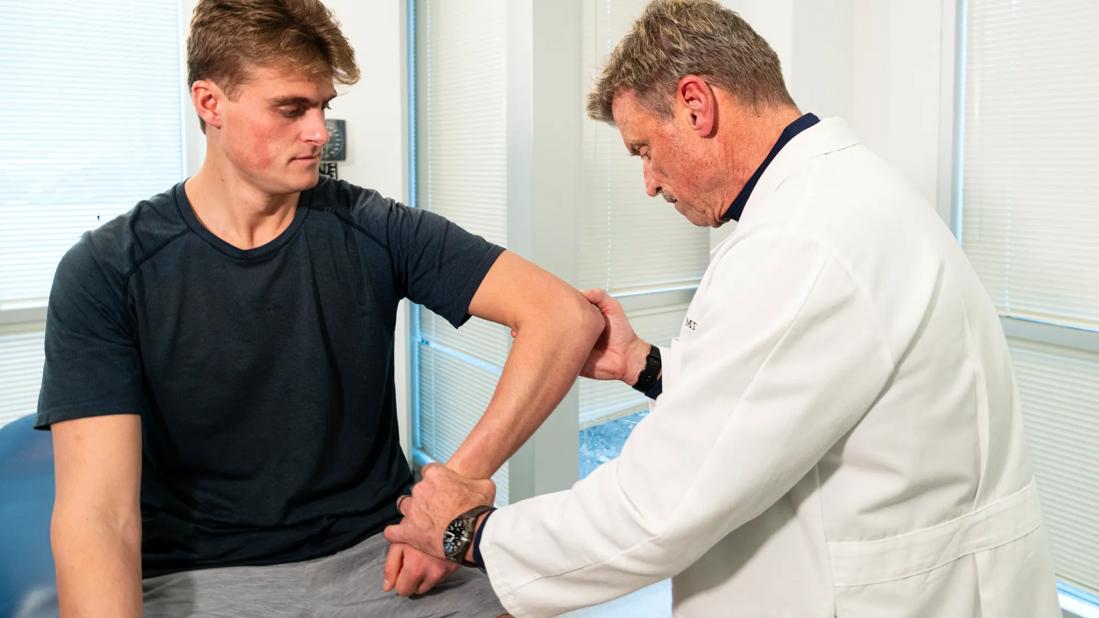Despite rising injuries, the trend towards personalized care is improving treatment approaches

Twenty-five years ago, if a throwing athlete had any kind of sprain at all in their ulnar collateral ligament (UCL) — regardless of the degree, location or severity — the treatment of choice was to go forward with a full reconstruction or Tommy John surgery.
Advertisement
Cleveland Clinic is a non-profit academic medical center. Advertising on our site helps support our mission. We do not endorse non-Cleveland Clinic products or services. Policy
“That’s not the case anymore,” explains Mark Schickendantz, MD, Professor of Orthopedic Surgery at Cleveland Clinic and Head Team Physician for the Cleveland Guardians. “Research performed here at Cleveland Clinic, as well as external studies, have shown us that UCL injuries vary significantly. Location and severity play a major role in management and outcomes, and the pendulum has swung towards a more individualized approach to care. We know that there’s much more to consider with UCL injuries than just automatically going straight to Tommy John surgery.”
Dr. Schickendantz believes that orthopaedic surgeons need to be more judicious about how UCL injuries — especially partial UCL tears — are treated. While full tears are typically best treated with full reconstruction, partial tears may not always require the surgical option. However, with a more individualized approach to care, the importance of an accurate and thorough diagnosis becomes an even greater priority.
While the classic “pop” sound or feeling associated with a UCL injury is typically a strong sign of an injury, there are several other signs and symptoms that can aide in the diagnosis and the extent and location of a UCL injury. The moving valgus maneuver is highly sensitive and specific for the presence of a UCL injury. Location of pain and tenderness are also important.
“If the history and physical examination has indicated a likely injury, advanced imaging such as an MRI is our best next step,” says Dr. Schickendantz. “We always start with an X-ray because there are bone details that we’re not going to be able to see as well on MRI. We’ve done studies that demonstrated that you can adequately assess the UCL without having to put contrast in the joint, so we don’t typically perform an arthrogram. However, we certainly do recommend a 3T magnet with sequencing that is specific for evaluating the UCL,
Advertisement
Dr. Schickendantz says that unless something is discovered on the patient’s physical exam, the imaging is typically concentrated on just the elbow and its surrounding structures, i.e., the flexor pronator mass, ulnar nerve and back of the joint.
“When you’re looking radiographically at a potential UCL injury, we’ve found that the best view is the coronal view,” he explains. “You can see it best on the T2 or the fat-suppressed images, and it’s important to look at the nature of the ligament itself and what the structure looks like. This is where you can find answers to the important questions – What does the ligament’s health look like? Does it appear chronic? Does it appear to be an acute injury? Where on the ligament is the injury?”
From Dr. Schickendantz’ s perspective, the location and severity of the injury are the two most critical considerations when determining treatment. He and his colleagues developed a six-stage MRI grading system that helps guide treatment based on those two factors.
“For example, a 1A grade would signify a partial tear of the proximal/humeral UCL — the number designates the location, and the letter represents the severity,” explains Dr. Schickendantz. “This type of injury would be considered a low-grade injury in a favorable location, so the patient is probably going to get better with physical therapy. On the other end of the spectrum, a 3B grade refers to a complete tear of the distal/ulnar UCL, which is a much more serious UCL injury and would usually require surgery. Grading an injury helps standardize treatment decisions, ensuring surgeons choose the best management – repair, reconstruction or non-operative — for recovery and return to play.”
Advertisement
When an athlete has a less severe injury, such as a 1A grade, Dr. Schickendantz recommends shutting down throwing activities for six weeks, followed by a six-week return-to-throw program.
“Even a low-grade injury requires three months to come back from, but it’s still a shorter time than the 12 to 18 months associated with coming back from a full reconstruction,” he says. “However, and I cannot stress this enough, it’s critical that the rest and rehabilitation time is not shortened, and the athlete returns too soon. If they commit to physical therapy and rest for the entire time, that injury will improve. But if they come back too soon, they’re really doing themselves a disservice because they can very likely injure themselves further. Non-operative treatment does not mean no treatment — it’s still a treatment, and it needs to be taken seriously and done the right way.”
While location and severity are the most important factors when determining treatment, it’s important to recognize that they can still be overruled by patient history.
“If they have injured the ligament in the past, even if they didn’t have surgery the first time, or even if the newer injury isn’t the most severe, their history may push us towards recommending surgery in that situation,” says Dr. Schickendantz.
“I think at this point, the general public is aware that the search for increased velocity among throwing athletes has led to an increase in the number of injuries we see on the medial side of the elbow,” says Dr. Schickendantz.
Advertisement
He also notes that orthopaedic surgeons are seeing an increased number of injuries beyond the UCL – the flexor pronator group has also been impacted.
While increased velocity has been a consistent priority for throwing athletes, a more recent focus has been on increasing spin rates. With higher spin rates, a pitcher can generate more movement and deception. A breaking ball will curve more sharply, and fastballs thrown with a high number of revolutions per minute (RPM) may lead to more rise and unpredictability.
“While spin rate may make a pitch harder to hit, it requires a great deal of force to generate the amount of spin where RPM makes a difference,” says Dr. Schickendantz. “A pitcher needs to grip the ball as firmly as they possibly can, and when they’re repetitively gripping the ball that hard, they’re fatiguing the dynamic stabilizers. So, for example, if the FCU and the FDS on the medial side of the elbow are fatigued, they don't protect the ligament, which can lead to increased stress seen by the ligament and perhaps increase the likelihood of injury.”
Where this becomes a problem, explains Dr. Schickendantz, is in the trickle-down nature of the sport – trends at the professional level typically make their way down to the college, high school and rec levels. So, while a professional player is typically fully developed, younger players, even at the high school and early collegiate level, still have open growth plates.
“It’s one thing where we’ve got all these Major League players going down,” says Dr. Schickendantz. “But their numbers pale in comparison to the thousands of younger athletes who are injuring their elbows every year as a result of these velocity and spin programs.”
Advertisement
He continues, “This is a trend that we may not fully understand the impact of until several years down the road. We could see the pool of throwing athletes at the college and professional level either become severely diluted because players have either already been phased out of the sport from injury history, or player careers are much shorter because of these injuries. Surgeons need to keep in mind, and educate their patients, that these aren’t lifespan operations — the average survival of a UCL reconstruction is about four years. So, this is why it’s important to focus on conservative treatment with younger patients that preserves the UCL for as long as possible.”
Dr. Schickendantz says there are some steps athletes can take to reduce their chance of injury. Although training has become a year-long process nowadays, young athletes need to take a break and allow their muscles and ligaments time to recover. A minimum break of three months between seasons is recommended, including a complete pause from pitching activities while maintaining strength and mobility exercises. If an injury comes up, it’s important not to push through it since it could lead to further damage. If the injury is deemed non-severe, it’s important to follow their provider’s recommendations and not try to come back too soon.
“There are so many anecdotes about pitchers having Tommy John and coming back better pitchers,” says Dr. Schickendantz. “I want to make clear that the surgery does not make a pitcher better. While their UCL may have been deteriorating and thus limiting their velocity before the injury, the surgery only restores the ligament. It’s really the rehab, which focuses on strength, core and mechanics, that is primarily what’s driving those improvements. But remember, the recovery process after Tommy John is between 12 and 18 months, and it’s a mentally and physically challenging process. So, when we have a partial UCL tear, that’s why we’re trying to explore all treatment options before committing to Tommy John surgery.”
Advertisement

How year-round play and cold weather impact young throwers — and what can be done to protect them

A tailored approach combining injections, therapy and preventive care is improving outcomes for patients with elbow OA

Clinical complexity demands personalized care strategies

Rest is often not the best care for gamers’ overuse injuries

Multidisciplinary care can make arthroplasty a safe option even for patients with low ejection fraction

Percutaneous stabilization can increase mobility without disrupting cancer treatment

Study shows that postop function is closer to normal than with total hip arthroplasty

Exploring new tools and techniques to improve the diagnosis and treatment of concussions.